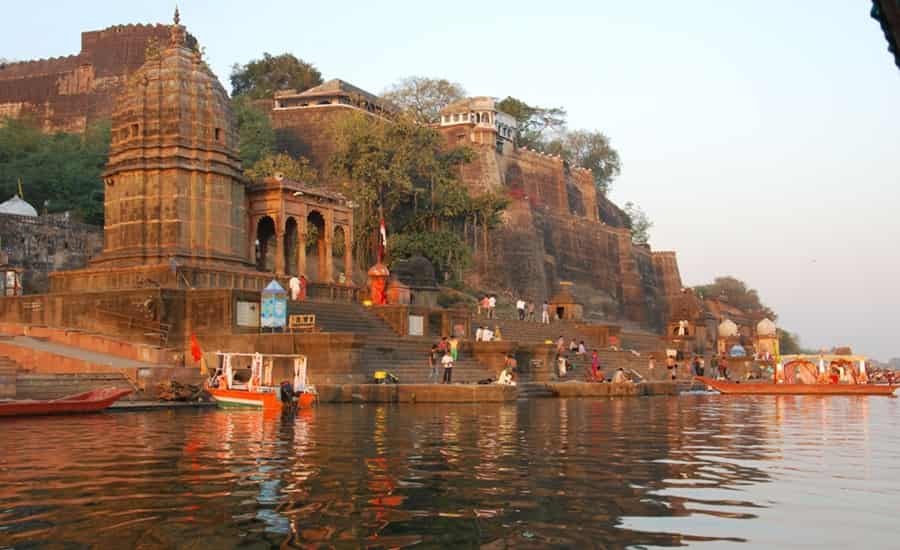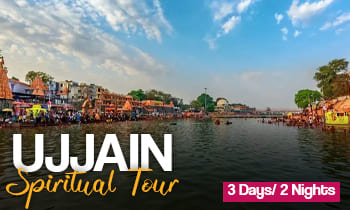The Omkareshwar Temple, also known as the Omkareshwar Jyotirlinga, is one of the most revered and ancient Hindu temples in India. Located on an island in the Narmada River, this temple holds a significant place in the hearts of millions of devotees and is an essential pilgrimage site for followers of Lord Shiva. This 2500-word essay will delve into the history, architecture, significance, and legends associated with the Omkareshwar Temple.

Historical Background
The history of the Omkareshwar Temple dates back to ancient times, and its origins are deeply rooted in Hindu mythology and legends. The temple is dedicated to Lord Shiva, one of the principal deities in Hinduism. The word “Omkareshwar” is derived from two words, “Om,” which is considered the most sacred sound in Hinduism, and “Ishwar,” which means Lord or God. Thus, Omkareshwar translates to “Lord of the Sacred Om.”
The temple is associated with one of the twelve Jyotirlingas, which are considered the most sacred abodes of Lord Shiva. The Jyotirlingas are believed to be self-manifested representations of Lord Shiva, and they hold immense spiritual significance for Hindus. Each of the twelve Jyotirlingas is associated with a unique legend and holds a special place in the hearts of devotees.
Legends Associated with Omkareshwar Temple
There are several legends associated with the Omkareshwar Temple. One of the most well-known legends is that of King Mandhata. According to Hindu mythology, King Mandhata was a righteous and pious ruler who performed intense penance to seek the blessings of Lord Shiva. Pleased with his devotion, Lord Shiva appeared before him and granted his wish. He asked for a divine lingam (a representation of Lord Shiva) to be established on an island in the Narmada River, and this island came to be known as Omkareshwar.
Another popular legend tells the story of Vindhya, a range of mountains in central India. It was believed that Vindhya mountains were growing taller and were challenging the Himalayas, which were considered the highest mountains on earth. This growth of Vindhya threatened to block the path of the sun, causing darkness on earth. To resolve this issue, the sage Agastya, a devotee of Lord Shiva, traveled to the Vindhya mountains and asked them to bow down in reverence to Lord Shiva. The Vindhya mountains obeyed the sage’s request and bowed down, stopping their growth.
Yet another legend is related to the story of Narmada, the holy river. It is believed that Narmada was deeply in love with Lord Shiva and wanted to be close to him. To please the Lord, Narmada performed severe penance. Touched by her devotion, Lord Shiva granted her the boon that he would reside in the form of a Jyotirlinga on an island in the Narmada River. This island, which became known as Omkareshwar, is considered a manifestation of Lord Shiva’s divine presence.
Architectural Splendor
The Omkareshwar Temple is a remarkable example of Hindu temple architecture. The temple complex comprises multiple structures, including the main temple, shrines, courtyards, and a sacred tank. The temple is built in the Nagara architectural style, which is characterized by its towering shikhara (spire) and intricate carvings.
The main sanctum of the temple houses the Jyotirlinga, which is the primary object of devotion for the pilgrims. The lingam is adorned with various ornaments and flowers by the temple priests. The sanctum is beautifully decorated with intricate carvings and sculptures of various deities and mythological figures.
The temple complex also features several smaller shrines dedicated to other deities, including Lord Ganesha, Goddess Parvati, and Lord Kartikeya. These shrines are exquisitely designed and add to the overall charm of the temple.
One of the most captivating features of the Omkareshwar Temple is the intricate artwork and carvings that adorn its walls and pillars. The carvings depict scenes from Hindu mythology, including the life and legends of Lord Shiva. These intricate carvings provide not only an aesthetic delight but also serve as a medium to convey the rich mythological narratives to the devotees.
The temple complex is surrounded by a series of courtyards and walkways, allowing pilgrims to circumambulate the sanctum and take in the divine atmosphere. The architecture and layout of the temple create a sense of peace and serenity, making it a perfect place for meditation and spiritual contemplation.
Significance and Pilgrimage
The Omkareshwar Temple holds immense significance in Hinduism, and it is considered one of the holiest pilgrimage sites for devotees of Lord Shiva. Pilgrims from all over India and even from other parts of the world visit the temple to seek the blessings of Lord Shiva and to experience the spiritual aura of this sacred place.
The temple is particularly renowned for its association with the Jyotirlinga of Lord Shiva. The twelve Jyotirlingas are considered the most powerful manifestations of Lord Shiva, and visiting them is believed to grant spiritual merit and liberation from the cycle of birth and death. Omkareshwar is one of the twelve Jyotirlingas, and its visit is a crucial part of the religious itinerary for Shiva devotees.
The island on which the temple is situated, surrounded by the Narmada River, is considered a highly auspicious location for worship. The Narmada River is itself revered as a holy river, and taking a dip in its waters is believed to cleanse one’s sins and purify the soul. Pilgrims often perform a parikrama, a circumambulation, of the entire island as an act of devotion.
Omkareshwar also holds special significance for scholars and seekers of knowledge. It has been a center for the study of Hindu philosophy and scriptures for centuries. The serene environment and the spiritual energy of the temple make it an ideal place for contemplation and meditation.
The temple attracts a diverse group of pilgrims, including saints, sadhus, scholars, and common devotees. It is not just a place of worship but also a hub of spiritual and cultural exchange.
Challenges and Preservation Efforts
While the Omkareshwar Temple is a symbol of spiritual and architectural excellence, it has faced its share of challenges over the centuries. The island on which the temple is situated is prone to flooding during the monsoon season, which has led to damage and restoration efforts at various times.
In recent years, there have been concerns about the environmental impact of increasing pilgrimage and tourism in the region. Efforts are being made to balance the preservation of the temple’s spiritual and architectural heritage with responsible tourism and environmental conservation.
Conclusion
The Omkareshwar Temple is a living testament to the rich spiritual and cultural heritage of India. Its history, legends, architectural beauty, and religious significance make it a place of deep devotion and reverence for millions of people. The temple serves as a symbol of Lord Shiva’s divine presence and provides a serene and sacred space for spiritual seekers and devotees.
Visiting the Omkareshwar Temple is not just a religious journey but also a cultural and historical experience. It allows individuals to connect with their spiritual roots and immerse themselves in the ancient traditions and wisdom of Hinduism. As a center of devotion, knowledge, and cultural exchange, the Omkareshwar Temple continues to be a timeless and revered institution in India.










 Call
Call WhatsApp
WhatsApp Enquiry
Enquiry